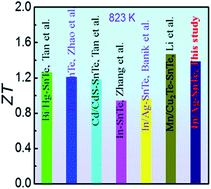Outstanding thermoelectric properties of solvothermal-synthesized Sn1−3xInxAg2xTe micro-crystals through defect engineering and band tuning†
Abstract
Due to the eco-friendly nature, tin telluride (SnTe) based thermoelectric materials have attracted extensive attention. Pristine SnTe suffers from low thermoelectric performance because of its large energy separation between two valence bands (heavy hole and light hole) and high thermal conductivity. In this study, we use In and Ag co-dopants to ameliorate the electrical and thermal transport properties of SnTe-based materials using a facile solvothermal method. From the theoretical calculation and performance evaluation, it can be observed that high-level In and Ag co-dopants can significantly converge two valence bands and increase the density of states near the Fermi level, leading to the enhanced Seebeck coefficient from ∼95 μV K−1 in the pristine SnTe to ∼178 μV K−1 in the Sn0.85In0.05Ag0.10Te. Comprehensive structural characterization shows that high-density strain fields and dislocations exist in the sintered pellets, together with the point defects, and grain boundaries secured the remarkably low lattice thermal conductivity of SnTe in the entire temperature range. As a result, a high peak figure of merit of ∼1.38 at 823 K has been achieved in Sn0.85In0.05Ag0.10Te, outperforming most of the SnTe-based materials. This study indicates that co-doping with high solubility can simultaneously tune the band structure and engineer defects for achieving enhanced thermoelectric performance of SnTe-based materials.



 Please wait while we load your content...
Please wait while we load your content...